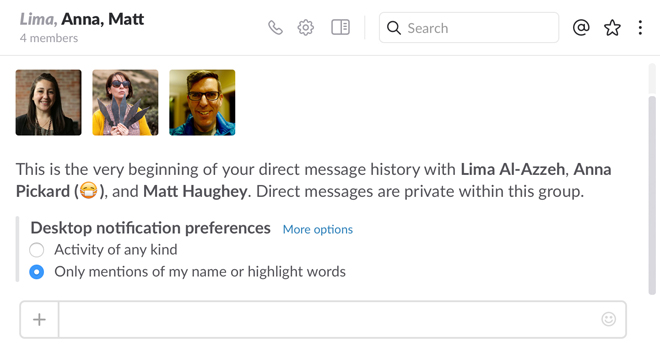There is an unchallenged assumption within the current conversation about the value of new group chat tools such as Slack and HipChat, which is that people innately know how to speak, write and listen effectively. I don’t mean that as an indictment of the creators or the users of these products, they simply take communication for granted. My seminar participants take this for granted as well, so an important part of my work is helping them see just how important it is to be aware of what human communication is and what it is not.
Many of my current training clients are firms that provide products and services in the computing, electronics and pharmacology sectors. No surprise, given that they are situated within nearby Sophia Antipolis, the leading European technology park. My work with the employees of such firms is focused on helping them communicate more effectively, both with their own colleagues as well as externally. As you might imagine, such communication takes place face to face, as well as via such media as phones, email and remote conferencing. But recently an increasing number of those I work with have expressed their dismay at the communication challenges posed by new team collaboration tools, with Slack leading the pack.

Central to such applications is a live group chat environment and it’s this that those in my seminars, and the global workforce, are increasingly concerned with. They wonder how to best manage the firehose of conversation in real time and when to resort to a single or group direct message (which ironically then becomes something similar to email, which Slack is supposed to supplant).
Sure, conversations within teams in theory can become much more open and over time these can form a searchable knowledge base. But the mental, physical and emotional drain of managing the flow of conversation can be significant. We forget that language is embodied and linked to emotions. And the fundamental challenge of communication remains — how do participants effectively coordinate their actions through language? Because none of us have been taught how to do so and current software solutions fail to incorporate what we know about how humans communicate. Where does that leave us when using tools such as Slack? On our own, alas, just as when using any other medium.
How Can You Simplify Communication?
I recently completed a series of seminars in which I trained all the employees of a market research firm specializing in the pharmaceutical sector. It’s based in France with satellite offices in Germany, Italy and Britain. In France, employees range from founders and employees going back 17 years to recent hires. They all speak at least two languages, sometimes three, and come from Italy, Spain, Colombia, different parts of France, Australia, Britain and the US. Their backgrounds run the gamut from marketing, IT, sciences, medicine and international businesses of all kinds, with English being the official corporate language.
The CEO didn’t need me to say much to persuade her to help them simplify their internal and external communication and find common ground. She was particularly intrigued by my question — Do you know that there is a universal language that is common to everyone regardless of age, profession, education or cultural background? By the end of the workshop, participants reported that they now experienced increased clarity and felt the relief that comes from simplifying communication. One participant, who had been with the company since the beginning, expressed that she felt as if a weight had been lifted off her shoulders.
Indeed, I’ve heard that from many of my other clients over the past decade of working in France with international companies. For most of us these days, communication can seem increasingly like a complex and heavy burden with which we are grappling not only intellectually but also physically and emotionally. The good news is that once you know how to simplify communication, and can clearly see what to do and why, and from that concretely intervene and troubleshoot miscommunication and agilely navigate any conversation, the burden dissolves.
Another comment I get from clients regularly is how obvious what I show them seems. Why had they never seen it before? Why had they been needlessly complicating their work lives? That’s why what I do produces such fast results. Everyone already knows these concepts but don’t know that they know them. Of course, even applying simplicity requires forming some new habits. However, it’s a process of stripping away what’s not necessary and getting back to the basics of all human communication — speech acts.

The Universal Language
Regardless of what communication medium you are using, there are only five things that happen in language to coordinate action with others: You make requests. You make offers. You make promises. You express your opinions with or without facts. You make declarations about your vision of the future on your own behalf or on behalf of others. The universal language is actually child’s play and everyone everywhere uses it constantly in all domains, more or less effectively and spontaneously.
What begins to complicate communication is that the way a Spanish person makes a request is different than the way a French, American or Indian person makes it. What complicates things still further is that when you work across cultures, even when you are using English as the common language, you expect others to make requests with the same form, tone and protocol as in your own culture. But when they don’t, misinterpretations, breach of trust, strained relationships and emotional reactionss can result.
In terms of coordinating action effectively, such nuances are irrelevant when working across cultures and only get in everyone’s way. Accordingly, I show all my clients how to ignore form and tone. Even when you are only receiving requests and offers, and expressing opinions by means of a series of tiny dots on a screen, you are interpreting tone and imagining the intentions behind what people are writing. That also contributes to the “noise” that people complain about in those mediums. Online, people complicate communication in just the same way as offline. So once you focus only on content, communication becomes clearer and easier, and you can be more neutral emotionally.
That takes practice. We’re all used to introducing countless levels of complexity to the simplest interactions. When communication gets increasingly intensive, as it does with tools like Slack, that habit doesn’t serve us well. Another major stumbling block is our inability to differentiate between facts, opinions and grounded opinions, which is covered in detail in my eBook, Dance of Opinions. A similar issue is not knowing the differences between declarations and promises. In short, once you reorient yourself to using speech acts simply but effectively, you will find yourself better equipped to handle the demands of live chat and direct messaging, regardless of what application your company deploys.
Coming Full Circle with Live Chat
On a historical note, I initially learned about speech acts almost 30 years ago from Fernando Flores, one of the founders of Action Technologies, an early developer of intranet groupware software based on J.L. Austen’s, How to Do Things with Words. Since I was taking management communication courses with Flores at the time, I was using that software, which embodies speech acts, in the early 90s. So I’ve come full circle when it comes to software but at least my clients and I are equipped to use these new tools with greater communication awareness and skills.
Jason Fried, the founder and CEO of web-based project management tool Basecamp, in an article minimizing the significance of Slack, despite this writes that at his company, “All together, we’ve messaged nearly 10,000,000 lines to one another at 37signals/Basecamp since 2006.” The question I would ask him that I bet he can’t answer, is how many of those lines are requests, offers, promises, facts, grounded opinions, ungrounded opinions and declarations? Imagine if each one had been color coded to identify its speech act. That would have helped everyone in real time be clearer in both their chatting and reading.
Of course, such a vision coming true would mean that I would instantly be replaced in my role of showing clients how to be rigorously and consistently clear and complete in each of the speech acts. Would I mind? Actually, I’d welcome that! I can only reach a limited number of people through my workshops and writing. Since I am absolutely convinced of the value of using speech acts as a way to make our present and future professional lives better, the power of automating communication tools to incorporate the universal language would be a great service to everyone, everywhere.
We build our future together in the words we exchange today. I’m afraid that Slack doesn’t know that. Yet.

This is the year you have decided to become a more effective intercultural communicator? Bravo! You can purchase and download my eBook, along with an 80-page workbook. Not sure? Read a free extract. Questions? Just ask.

